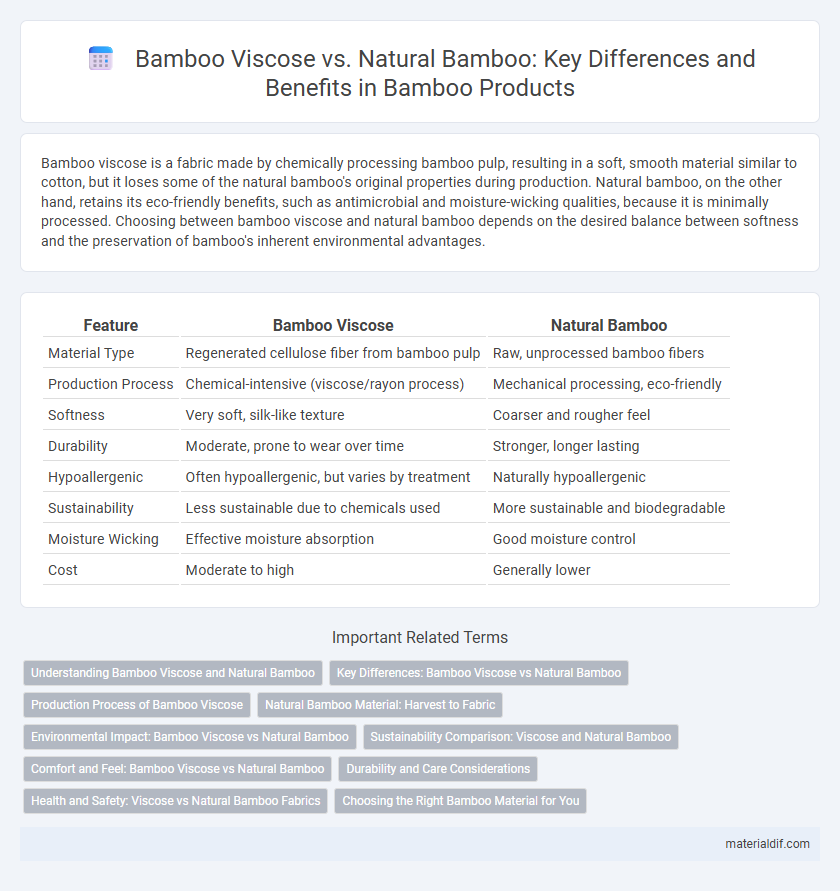Bamboo viscose is a fabric made by chemically processing bamboo pulp, resulting in a soft, smooth material similar to cotton, but it loses some of the natural bamboo's original properties during production. Natural bamboo, on the other hand, retains its eco-friendly benefits, such as antimicrobial and moisture-wicking qualities, because it is minimally processed. Choosing between bamboo viscose and natural bamboo depends on the desired balance between softness and the preservation of bamboo's inherent environmental advantages.
Table of Comparison
| Feature | Bamboo Viscose | Natural Bamboo |
|---|---|---|
| Material Type | Regenerated cellulose fiber from bamboo pulp | Raw, unprocessed bamboo fibers |
| Production Process | Chemical-intensive (viscose/rayon process) | Mechanical processing, eco-friendly |
| Softness | Very soft, silk-like texture | Coarser and rougher feel |
| Durability | Moderate, prone to wear over time | Stronger, longer lasting |
| Hypoallergenic | Often hypoallergenic, but varies by treatment | Naturally hypoallergenic |
| Sustainability | Less sustainable due to chemicals used | More sustainable and biodegradable |
| Moisture Wicking | Effective moisture absorption | Good moisture control |
| Cost | Moderate to high | Generally lower |
Understanding Bamboo Viscose and Natural Bamboo
Bamboo viscose is a semi-synthetic fiber produced by chemically processing bamboo pulp, resulting in a soft, smooth fabric often used in clothing and textiles. Natural bamboo, in contrast, refers to the raw plant material harvested directly from the bamboo stalk, valued for its sustainability, strength, and versatility in construction and crafts. Understanding the differences highlights that bamboo viscose involves significant chemical treatment, whereas natural bamboo remains in its original, eco-friendly form.
Key Differences: Bamboo Viscose vs Natural Bamboo
Bamboo viscose is a manufactured fiber derived through chemical processing of bamboo cellulose, while natural bamboo refers to the raw, unprocessed bamboo plant itself. The transformation into bamboo viscose involves intensive chemical treatments that alter the fiber's properties, resulting in a softer, more textile-friendly material compared to the coarse texture of natural bamboo fibers. Natural bamboo offers greater environmental benefits due to minimal processing, whereas bamboo viscose may raise sustainability concerns due to the use of solvents and energy in production.
Production Process of Bamboo Viscose
Bamboo viscose is produced through a chemical-intensive process that dissolves bamboo cellulose in sodium hydroxide and carbon disulfide to create a viscous solution, which is then spun into fibers. This production method contrasts with natural bamboo fiber extraction, which mechanically crushes and enzymatically treats bamboo to retain its natural structure without harsh chemicals. The viscose process generates more environmental pollution and energy consumption compared to the more eco-friendly mechanical extraction of natural bamboo fibers.
Natural Bamboo Material: Harvest to Fabric
Natural bamboo material undergoes a sustainable harvesting process where mature bamboo stalks are cut without uprooting, allowing rapid regrowth and minimal environmental impact. The harvested bamboo is mechanically crushed and spun into fibers without the use of harsh chemicals, preserving the eco-friendly qualities of the raw material. This mechanical process distinguishes natural bamboo fabric from bamboo viscose, which involves chemical treatments that affect the fiber's sustainability and biodegradability.
Environmental Impact: Bamboo Viscose vs Natural Bamboo
Bamboo viscose involves chemical processing that can release harmful pollutants and consume significant water and energy resources, impacting the environment negatively. Natural bamboo, by contrast, is biodegradable, requires minimal pesticides or fertilizers, and grows rapidly, making it a more sustainable and eco-friendly choice. Choosing natural bamboo reduces chemical waste and promotes soil health compared to the industrial processes used in bamboo viscose production.
Sustainability Comparison: Viscose and Natural Bamboo
Bamboo viscose production involves chemical processing that can lead to environmental pollution and high water consumption, impacting its overall sustainability negatively compared to natural bamboo. Natural bamboo is a fast-growing, renewable resource requiring minimal pesticides and water, making it a more eco-friendly choice. The sustainability advantage of natural bamboo lies in its biodegradability and lower carbon footprint throughout its lifecycle.
Comfort and Feel: Bamboo Viscose vs Natural Bamboo
Bamboo viscose offers a silky-smooth texture and excellent moisture-wicking properties, making it highly comfortable for everyday wear. Natural bamboo fibers, while eco-friendly and breathable, tend to feel coarser and less soft compared to bamboo viscose. The regenerated process in bamboo viscose enhances its softness and durability, providing a luxurious feel superior to that of untreated natural bamboo.
Durability and Care Considerations
Bamboo viscose, a regenerated fiber derived from bamboo cellulose, offers a softer texture but typically has lower durability compared to natural bamboo fibers, which retain the plant's inherent strength and resilience. Caring for bamboo viscose requires gentle washing and avoiding high heat to prevent weakening and shrinkage, while natural bamboo textiles are more robust, tolerating standard laundering with less risk of damage. Choosing between bamboo viscose and natural bamboo depends on the balance of softness and longevity needed for specific textile applications.
Health and Safety: Viscose vs Natural Bamboo Fabrics
Bamboo viscose undergoes extensive chemical processing involving solvents like carbon disulfide, potentially causing skin irritation and respiratory issues, raising health and safety concerns. Natural bamboo fabric, made through mechanical crushing and retting, retains more of the bamboo's original properties and generally poses fewer risks of chemical exposure. Choosing natural bamboo fabric minimizes harmful chemical contact, offering a safer option for sensitive skin and environmentally conscious consumers.
Choosing the Right Bamboo Material for You
Bamboo viscose is a chemically processed fabric derived from bamboo pulp, offering a soft, smooth texture ideal for clothing and bedding but with less environmental benefit compared to Natural bamboo, which is minimally processed, retaining its natural antimicrobial properties and sustainability. Choosing the right bamboo material depends on your priority for eco-friendliness versus fabric feel; natural bamboo is better for eco-conscious consumers seeking organic qualities, while bamboo viscose suits those prioritizing softness and versatility. Consider factors like chemical usage, biodegradability, and end-use preferences to make an informed decision between bamboo viscose and natural bamboo products.
Bamboo viscose vs Natural bamboo Infographic

 materialdif.com
materialdif.com